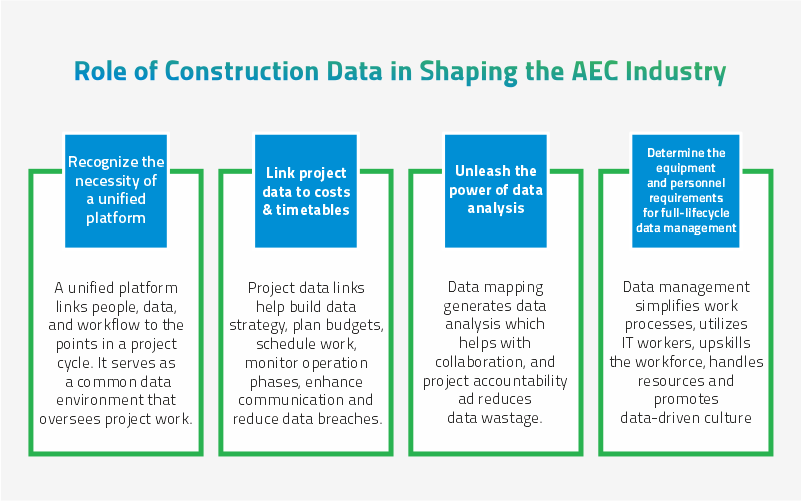Last Updated on November 23, 2023 by softtech
Global digitization has had a tremendous impact on every industry, and the AEC industry is no different. Consistent software use and the digitization of construction activities have increased data generation. In the AEC industry, data are never in short supply. Every project generates enormous amounts of construction data, from design and planning to turnover and beyond. However, one of the most significant challenges that stakeholders face is access to the right data at the right time. This stage is essential for better decision-making and insight finding.

Recognize the necessity of a unified platform
The developed data must be accessible to the decision-makers in order to be useful. Due to its accessibility, the consumers can make sense of the data. This necessitates that the data be obtained on a single platform. What does this shared platform stand for? A unified platform is one that connects people, data, and workflow at all stages of the project cycle. A strategic planning process is accelerated and integrated by the unified platform.
A unified platform, also known as a shared data environment, serves as an accurate single source of truth. The platform serves as construction management software with APIs that enable designers and engineers access to data and tools, thus it is more than just a collection of APIs that connect to a SaaS solution. The integrated platform aids in the development and distribution of other parties’ products. The synchronization of the product work is also managed by the unified platform. The process of sharing data is streamlined by using a single platform.
Link project data to costs and timetables
For projects to be successful, cost certainty is crucial. The budgets can be easily managed and coordinated with real-time project data on the unified platforms. When you adhere to the timeline and budget, customers are happy and willing to work with you on future projects. Profit margins are raised by effective budget management. According to study, 60% of project failures are the result of poor scheduling, working overtime, and overspending. While inaccurate construction data negatively impacts the project’s budget, accurate data increases profit margins.
Construction companies need a data plan to combat the effects of inaccurate data. Construction data and technology are game changers when it comes to budgeting, scheduling, and assuring client satisfaction. The data has an impact on the construction lifecycle’s design, planning, building, and operating phases. To avoid data management problems, construction organisations must interact, link, and integrate data schedules using scheduling solutions. The scheduling tools aid in preventing cost growth.
Unleash the power of data analysis
The data analysis results in wise choices. Architecture data mapping unlocks the potential of data analysis. A better knowledge of data use is provided by data mapping. The data analysis establishes the unified platform’s lone source of truth for the data acquired. Collaboration, accountability, and data waste are all improved via data analysis.
Determine the equipment and personnel requirements for full-lifecycle data management
Data storage is a challenging process. Data may be obtained by AECO stakeholders more easily by streamlining complex data production and storage procedures. Due to a lack of connectedness, the background-running systems have an impact on collaboration and thought processes. The AEC businesses must be careful in the tools and technology they select if they want to build up the systems for successful lifetime data analysis. Internal IT staff members can be used to simplify processes. A data-driven culture is promoted by upskilling the workforce with the help of internal and external resources, which boosts data creation.
According to studies, construction software platforms make decisions based on the obtained data. A unified platform facilitates increased data accessibility throughout the AECO lifecycle. Implementing a data management plan promotes data analysis and aids in the setup of the data infrastructure systems. The AEC industry may drastically change if construction data were to be used more effectively.
About Author
Olivia Jones
Technology Specialist
Olivia is a highly skilled and experienced Technology Specialist with 10+ years of hands-on expertise in the rapidly evolving field of technology. She has a proven track record of successfully implementing and managing a wide range of technological solutions, ensuring optimal performance and efficiency. Olivia possesses a deep understanding of industry trends and emerging technologies, enabling her to provide strategic guidance and drive innovation within organizations. With a strong focus on problem-solving, she consistently delivers tailored solutions that align with business objectives while maximizing productivity and cost-effectiveness.
About SoftTech Engineers
A leading IT company (www.softtech-engr.com) facilitating business and technology transformation across the AEC industry through innovative software products and solutions. Equipped with 25+ years of deep domain expertise and industry knowledge, SoftTech has helped more than 4500 clients & government organizations, with more than 25000 users in India and around the world to gain a competitive edge and lead from the front in the industry.

